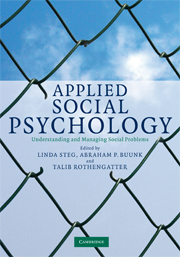Book contents
- Frontmatter
- Contents
- List of figures
- List of tables
- List of boxes
- List of contributors
- Acknowledgments
- 1 Introduction to applied social psychology
- 2 The USE of theory in applied social psychology
- 3 Applications of social psychology to increase the impact of behaviour-focused intervention
- 4 Research designs in applied social psychology
- 5 Social psychology and economic behaviour: heuristics and biases in decision making and judgement
- 6 Social psychology and immigration: relations between immigrants and host societies
- 7 Applying social psychology to the classroom
- 8 Social psychology and environmental problems
- 9 Gender issues in work and organizations
- 10 Social psychology of health and illness
- 11 Social psychology and mental health
- 12 Social psychology and modern organizations: balancing between innovativeness and comfort
- 13 Social psychology and the study of politics
- Index
- References
4 - Research designs in applied social psychology
- Frontmatter
- Contents
- List of figures
- List of tables
- List of boxes
- List of contributors
- Acknowledgments
- 1 Introduction to applied social psychology
- 2 The USE of theory in applied social psychology
- 3 Applications of social psychology to increase the impact of behaviour-focused intervention
- 4 Research designs in applied social psychology
- 5 Social psychology and economic behaviour: heuristics and biases in decision making and judgement
- 6 Social psychology and immigration: relations between immigrants and host societies
- 7 Applying social psychology to the classroom
- 8 Social psychology and environmental problems
- 9 Gender issues in work and organizations
- 10 Social psychology of health and illness
- 11 Social psychology and mental health
- 12 Social psychology and modern organizations: balancing between innovativeness and comfort
- 13 Social psychology and the study of politics
- Index
- References
Summary
Research designs in applied social psychology
In 1999, Eric Harris and Dylan Klebold launched an assault on Columbine High School in Littleton, Colorado, murdering 13 people and wounding 23 before killing themselves. Similar school shootings have occurred in other communities, such as Paducah, Kentucky, Jonesboro, Arkansas, and, most recently, Blacksburg, Virginia. Although the exact causes for these attacks may never be known, one characteristic that these events share is that all the shooters were young adults who habitually played violent video games.
Since their introduction thirty years ago, video games have become increasingly violent. A review conducted in 1998 indicated that 80 per cent of video games on the market were violent in nature (Dietz, 1998). Unfortunately, little is known about the consequences of such exposure. Craig Anderson, along with his colleagues, has attempted to address this important social issue by designing a programme of research that investigates the relation between violent video game use and aggression. In our opinion, this line of research represents an ideal for the applied social scientist. Anderson and his colleagues created a research programme that uses multiple studies with multiple designs in order to investigate a socially relevant topic. As a result, our chapter will use this work as a springboard for discussing research design in applied social psychology.
Selecting a research method
Once a researcher decides upon the applied topic to be studied, the most important issue to address in designing a given study is determining which type of method to use.
- Type
- Chapter
- Information
- Applied Social PsychologyUnderstanding and Managing Social Problems, pp. 87 - 116Publisher: Cambridge University PressPrint publication year: 2008
References
- 3
- Cited by



